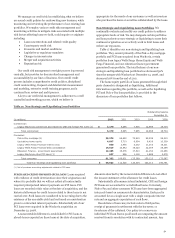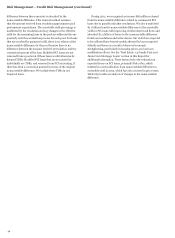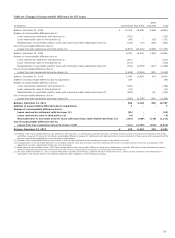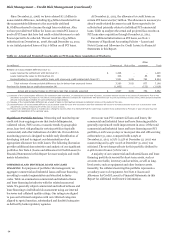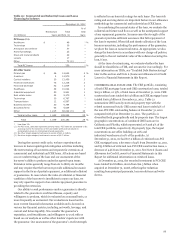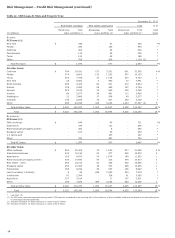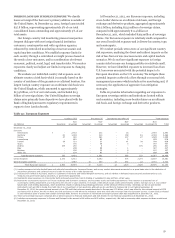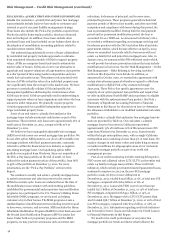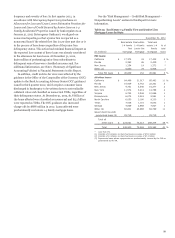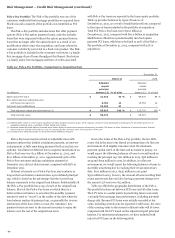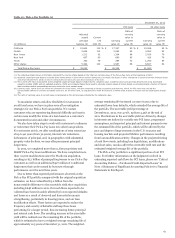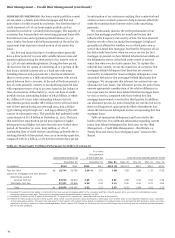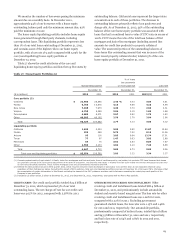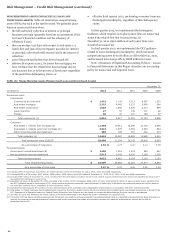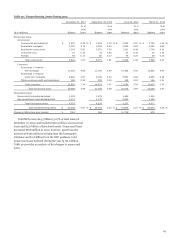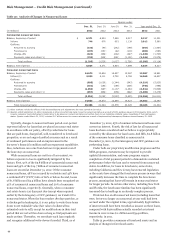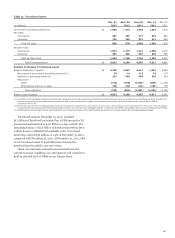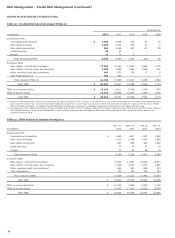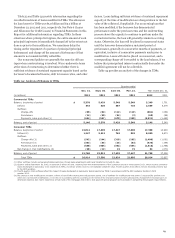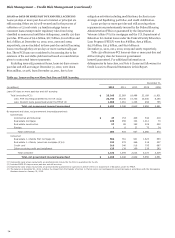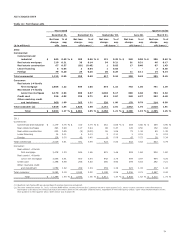Wells Fargo 2012 Annual Report Download - page 63
Download and view the complete annual report
Please find page 63 of the 2012 Wells Fargo annual report below. You can navigate through the pages in the report by either clicking on the pages listed below, or by using the keyword search tool below to find specific information within the annual report.
Table 25: Pick-a-Pay Portfolio (1)
December 31, 2012
PCI loans All other loans
Ratio of Ratio of
Adjusted carrying carrying
unpaid Current value to value to
principal LTV Carrying current Carrying current
(in millions) balance (2) ratio (3) value (4) value (5) value (4) value (5)
California $ 21,642 113 % $ 17,337 90 % $ 15,586 82 %
Florida 2,824 112 2,262 85 3,265 93
New Jersey 1,213 92 1,204 88 2,056 79
New York 697 90 680 85 916 79
Texas 303 79 284 73 1,290 64
Other states 5,324 102 4,567 86 8,827 84
Total Pick-a-Pay loans $ 32,003 $ 26,334 $ 31,940
(1) The individual states shown in this table represent the top five states based on the total net carrying value of the Pick-a-Pay loans at the beginning of 2012.
(2) Adjusted unpaid principal balance includes write-downs taken on loans where severe delinquency (normally 180 days) or other indications of severe borrower financial stress
exist that indicate there will be a loss of contractually due amounts upon final resolution of the loan.
(3) The current LTV ratio is calculated as the adjusted unpaid principal balance divided by the collateral value. Collateral values are generally determined using automated
valuation models (AVM) and are updated quarterly. AVMs are computer-based tools used to estimate market values of homes based on processing large volumes of market
data including market comparables and price trends for local market areas.
(4) Carrying value, which does not reflect the allowance for loan losses, includes remaining purchase accounting adjustments, which, for PCI loans may include the
nonaccretable difference and the accretable yield and, for all other loans, an adjustment to mark the loans to a market yield at date of merger less any subsequent charge-
offs.
(5) The ratio of carrying value to current value is calculated as the carrying value divided by the collateral value.
To maximize return and allow flexibility for customers to
avoid foreclosure, we have in place several loss mitigation
strategies for our Pick-a-Pay loan portfolio. We contact
customers who are experiencing financial difficulty and may in
certain cases modify the terms of a loan based on a customer’s
documented income and other circumstances.
We also have taken steps to work with customers to refinance
or restructure their Pick-a-Pay loans into other loan products.
For customers at risk, we offer combinations of term extensions
of up to 40 years (from 30 years), interest rate reductions,
forbearance of principal, and, in geographies with substantial
property value declines, we may offer permanent principal
forgiveness.
In 2012, we completed more than 11,800 proprietary and
HAMP Pick-a-Pay loan modifications. We have completed more
than 111,000 modifications since the Wachovia acquisition,
resulting in $5.1 billion of principal forgiveness to our Pick-a-Pay
customers as well as an additional $427 million of conditional
forgiveness that can be earned by borrowers through
performance over the next three years.
Due to better than expected performance observed on the
Pick-a-Pay PCI portfolio compared with the original acquisition
estimates, we have reclassified $3.0 billion from the
nonaccretable difference to the accretable yield since acquisition
including $648 million in 2012. Our cash flows expected to be
collected have been favorably affected by lower expected defaults
and losses as a result of observed and forecasted economic
strengthening, particularly in housing prices, and our loan
modification efforts. These factors are expected to reduce the
frequency and severity of defaults and keep these loans
performing for a longer period, thus increasing future principal
and interest cash flows. The resulting increase in the accretable
yield will be realized over the remaining life of the portfolio,
which is estimated to have a weighted-average remaining life of
approximately 12.5 years at December 31, 2012. The weighted-
average remaining life increased 1.5 years in 2012 due to
estimated lower loan defaults, which extended the average life of
the portfolio. The accretable yield percentage at
December 31, 2012, was 4.70%, up from 4.45% at the end of
2011. Fluctuations in the accretable yield are driven by changes
in interest rate indices for variable rate PCI loans, prepayment
assumptions, and expected principal and interest payments over
the estimated life of the portfolio, which will be affected by the
pace and degree of improvements in the U.S. economy and
housing markets and projected lifetime performance resulting
from loan modification activity. Changes in the projected timing
of cash flow events, including loan liquidations, modifications
and short sales, can also affect the accretable yield rate and the
estimated weighted-average life of the portfolio.
The Pick-a-Pay portfolio is a significant portion of our PCI
loans. For further information on the judgment involved in
estimating expected cash flows for PCI loans, please see “Critical
Accounting Policies – Purchased Credit-Impaired Loans” in
Note 1 (Summary of Significant Accounting Policies) to Financial
Statements in this Report.
61


